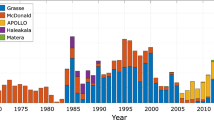Abstract.
The initial value problem and the stability of solution in the determination of the coordinates of three observing stations and four retro-reflectors by lunar laser ranging are discussed. Practical iterative computations show that the station coordinates can be converged to about 1 cm, but there will be a slight discrepancy of the longitudinal components computed by various analysis centers or in different years. There are several factors, one of which is the shift of the right ascension of the Moon, caused by the orientation deviation of the adopted lunar ephemeris, which can make the longitudinal components of all observing stations rotate together along the longitudinal direction with same angle. Additionally, the frame of selenocentric coordinates is stable, but a variation or adjustment of lunar third-degree gravitational coefficients will cause a simultaneous shift along the reflectors' longitudes or rotation around the Y axis.
Similar content being viewed by others
Author information
Authors and Affiliations
Additional information
Received: 21 August 1996 / Accepted: 17 November 1998
Rights and permissions
About this article
Cite this article
Huang, C., Jin, W. & Xu, H. The terrestrial and lunar reference frame in lunar laser ranging. Journal of Geodesy 73, 125–129 (1999). https://doi.org/10.1007/s001900050227
Issue Date:
DOI: https://doi.org/10.1007/s001900050227




